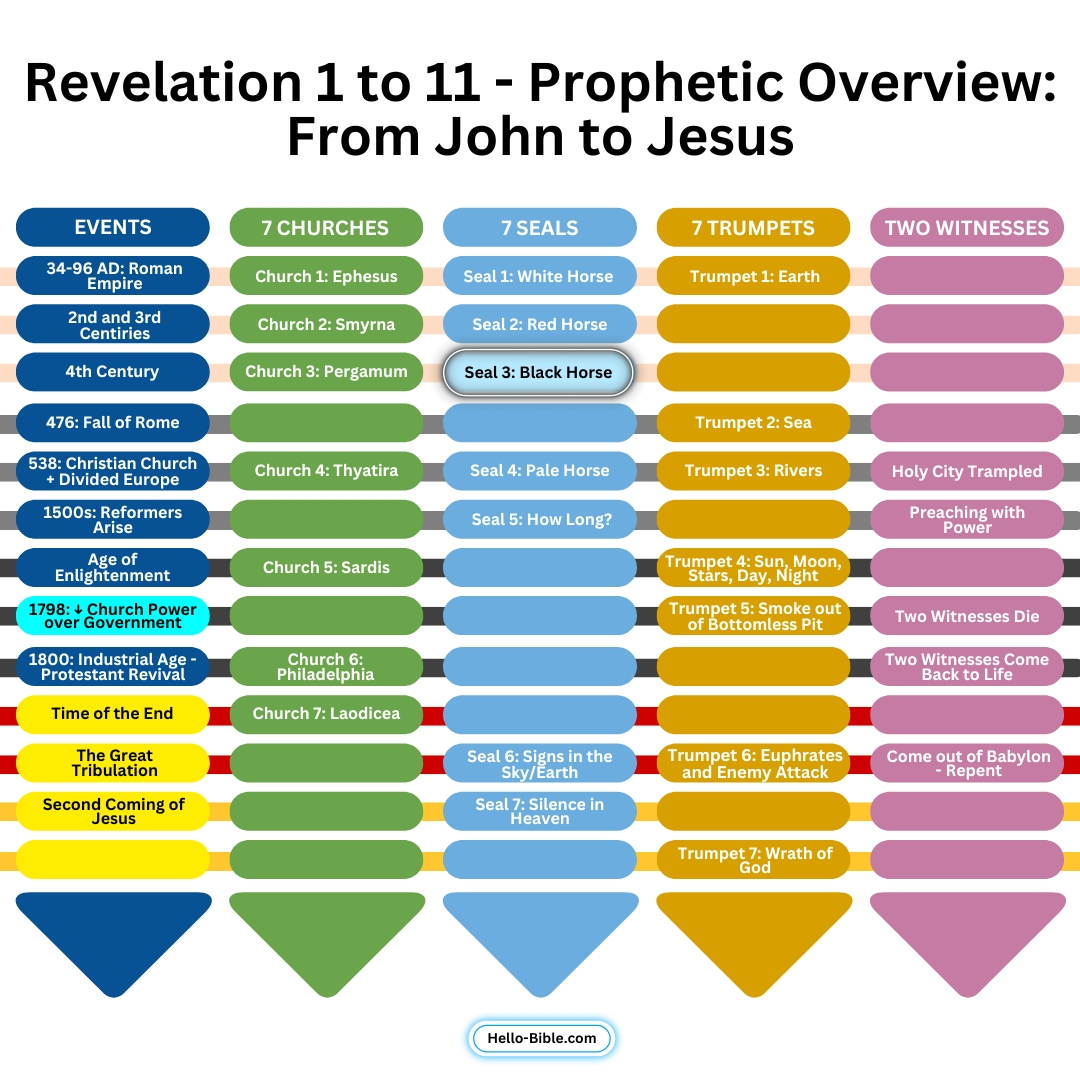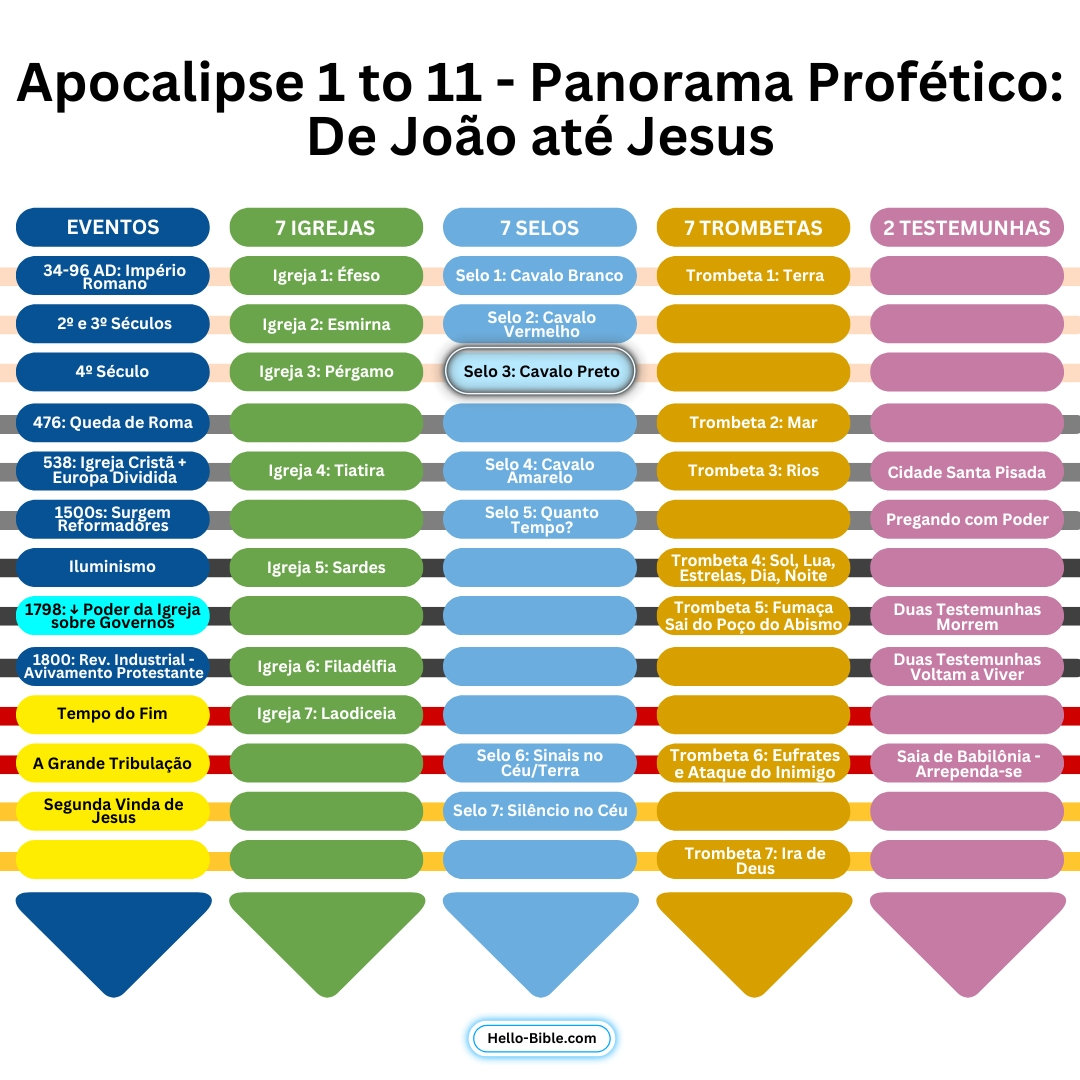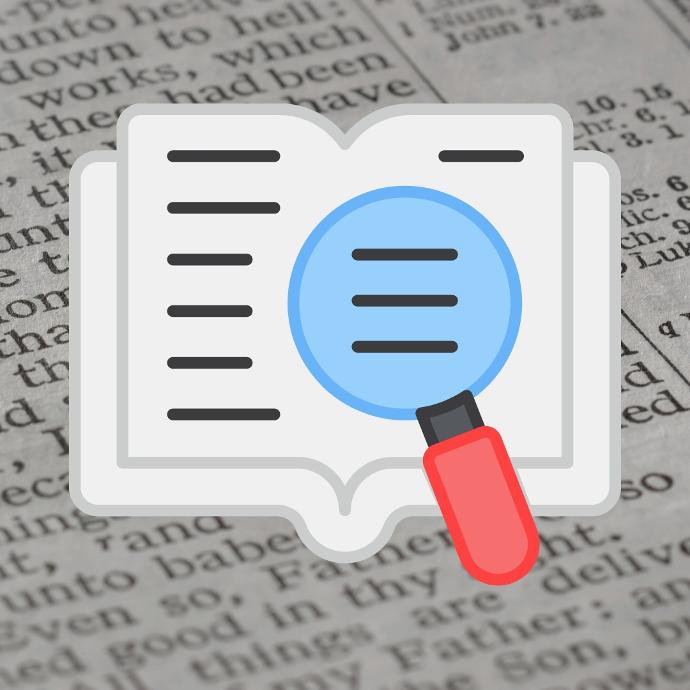5 And when he had opened the third seal, I heard the third living creature say, Come and see. And I beheld, and lo a black horse; and he that sat on it had a pair of balances in his hand.
6 And I heard a voice in the midst of the four living creatures say, A measure of wheat for a penny, and three measures of barley for a penny; and see you hurt not the oil and the wine.
Drawing Connections
So far we've seen Jesus open the first 2 seals. The breaking of the seals in Heaven cause an event on Earth. With the braking of the first seal, a white horse and rider were called to go spread the Gospel and conquer people for God. With the second seal, a red horse and rider were called to go to Earth and highlight God's people, those who had accepted the message being spread. Their accepting the Gospel caused them to stick out in their society, which quickly moved their opponents to see them as easy targets. Consequently persecution and suffering happened. We saw that both riders so far are a symbol for Jesus and the work His life, sacrifice and resurrection have done for humanity. Now, Jesus is opening the third seal. One of the living creatures calls forth a black horse and its rider to complete another mission on Earth.
Closer Look
*** The color Black ***: The color black shows up again in Revelation 6:12, where we read: “[...] the sun became black as sackcloth of hair [...]”. Black relates to a period of darkness. Several texts in the New Testament refer to the condition of living in darkness, as the time when a person has not been exposed to the message of God (Matthew 4:16; Luke 1:79; John 1:5; John 3:19; Acts 26:18; Colossians 1:13). It’s a period of spiritual famine.
*** The third living creature ***: Likely, this was the creature having the face like a man, since the order in which the creatures calling out the horses appear seem to match the order in which the beings in Revelation 4:7 are mentioned. The human aspect of this being seems to emphasize the spiritual nature of the calling. To help us understand how the humanity and spirituality are connected, let’s look in the book of Daniel, and read about the transformation of Nebuchadnezzar (Daniel 4:28-37). When he attributed to himself all the glory for what he had accomplished, he went from being the king of Babylon (the symbol for Babylon was a lion with wings), to becoming an animal who grazed like an ox. And his hair became like eagle feathers (Daniel 4:33). Once he recognized and praised the everlasting God, his humanity returned to him (Daniel 4:34-36). We can find in this account the same elements (lion, oxen, man, and eagle) that we see in the living beings of Revelation. It is interesting to note that Nebuchadnezzar had a before and after moment of his humanity. Initially without recognizing God, and later, when he was transformed, after he had a deep spiritual experience. The king of Babylon had answered to the call for repentance.
*** The rider had a pair of balances in his hand ***: the expression ‘pair of balances’ used here was translated from the Greek zugos, which means not only a weighing device, but also a yoke that was put on a pair of oxen, to make them work as one unit. In the Old Testament, the word scale (or balance) was used to represent famine. Eating bread by weight meant that food was scarce and was being rationed (Leviticus 26:26). Because of Israel’s disobedience, God disciplined them by cutting the supply of bread and water, and providing them just the minimum necessary - an amount that was to be measured (Ezekiel 4:16).
Pair of balances

© Hello-Bible - 2024
*** The shouting out of the price ***: Someone who was in the midst of the living beings shouted out the price of the food being rationed. It is not clear who is talking. Since the voice comes from near the beings, it is possible that it was the Father speaking, because the voice had the authority to determine the price of the wheat and the barley. Not only that, it also had the power to order that nothing happen to the oil and the wine.
*** “A measure of wheat for a penny, and three measures of barley for a penny” ***: The word ‘penny’ is actually the word denarius in the Greek manuscripts. The denarius was a Roman coin. One denarius equaled how much money a worker would make in one day. Back then, grain was one of the main basic necessity crops in Palestine. Wheat was a considered the main staple food, and barley was for the poor. One measure of wheat was enough to feed one person only. Three measures of barley could feed more people, but it was an inferior grain. In other words, the voice is saying that the situation is so serious, that it would take the entire day’s wage just to buy food. There would be no money left for anything else.
*** “Hurt not the oil and the wine” ***: While the price of the grain is severely inflated, there is no pricing on the oil or the wine. Consumption of those two things are not limited. The Old Testament mentions oil and wine as common necessities of daily living (Deuteronomy 7:13; Deuteronomy 11:14; Deuteronomy 28:51; 2 Chronicles 32:28; Hosea 2:8,22; Joel 2:19). Olive trees and vines are able to tolerate drought more easily than grain, so in an actual drought, grains would be the first to suffer. The famine portrayed in the third seal is partial, since not all items in their diet were restricted.
*** Symbolic and prophetic application ***: Continuing the symbolic line of thought presented so far with the previous 2 horses and riders, we must also understand the spiritual message the third horseman is carrying. The first horse symbolizes the spread of the Gospel. The second horse symbolizes what happens when people accept or reject the message of the Gospel. And so, the famine portrayed with the going forth of the third horse must also relate to a spiritual famine, where access to the Word of God is limited. It is likely a consequence of the rejection of the message. In Amos 8:10-13, we read what God is telling the prophet: “Behold, the days come, says the Lord GOD, that I will send a famine in the land, not a famine of bread, nor a thirst for water, but of hearing the words of the LORD: And they shall wander from sea to sea, and from the north even to the east, they shall run to and fro to seek the word of the LORD, and shall not find it. In that day shall the fair virgins and young men faint for thirst.” God is talking about a spiritual famine; a famine “of hearing the words of the LORD”. The Word of God is compared to grain (Matthew 13:3-30; Luke 8:11); to the Bread of Life (Matthew 4:4); and to Jesus himself (John 6:35-58; 1 Corinthians 10:16; John 1:1,14,29).
In the Bible, the Israelite leaders had to be anointed with oil, as a sign that God had selected them for the job (Leviticus 8:12; 1 Samuel 10:1). Oil, then, can be understood as a symbol for the Holy Spirit (Acts 10:34-43; 1 John 2:20-28). Wine can represent salvation through the blood of Jesus, shed on behalf of His children (Matthew 26:27-29; Mark 14:23-25; Luke 22:20). John 15:1-11 says that Jesus is the true vine. Salvation comes through Him.
The 3rd seal marks a parallel with the church of Pergamum, where false doctrines started to enter the church, diluting the message of the Gospel. Division in the church over which beliefs to follow is an evidence of a great spiritual war. The more people move away from the original message, the more serious the spiritual drought and consequent famine. But not all hope is lost. To the overcomer in Pergamum, Jesus promised that he would give him to eat of the hidden mana. The true followers of the Lord, who remain faithful to Him, will one day receive Christ Himself, and Will never hunger for the Word again.

© Hello-Bible - 2024

© Hello-Bible - 2024
Overview
The black horse and rider come out of heaven with the power to control the resources available on Earth, with His scale. But salvation and the work of the Holy Spirit were to be unaffected by the spiritual drought, because those activities are independent of human choice. Those are divine operations. Accepting or rejecting the Bread of Life is, on the other hand, a human prerogative. By rejecting Him, people will bring about a miserable condition of spiritual drought and famine. With this understanding, we can see that the rider on this black Horse is Jesus. With His scales He is showing the world the consequences of rejecting His message, but at the same time, He guarantees that His promise of the Holy Spirit and of Eternal Life continue to be unaltered and available to anyone who believes.
